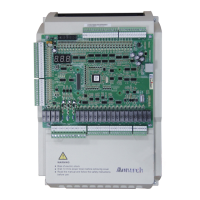- 68 -
Function Code Parameter Name Setting Range Default Remarks
F8-02 Pre-torque offset 0.0%–100.0% 50.0%
These are pre-torque
regulating parameters.
F8-03 Drive gain 0.00–2.00 0.60
F8-04 Brake gain 0.00–2.00 0.60
When F8-01 is set to 1 (Load cell pre-torque compensation), the system with a load cell pre-
outputs the torque matched the load to ensure the riding comfort of the elevator.
•
Motor driving state: full-load up, no-load down
•
Motor braking state: full-load down, no-load up
F8-02 (Pre-torque offset) is actually the elevator balance coefcient, namely, the percentage
of the car load to the rated load when the car and counterweight are balanced.
F8-03 (Drive gain) or F8-04 (Brake gain) scales the elevator’s present pre-torque coefcient
when the motor runs at the drive or brake side. If the gain set is higher, then the calculated
value of startup pro-torque compensation is higher. The controller identifies the braking
or driving state according to the load cell signal and automatically calculates the required
torque compensation value.
When an analog device is used to measure the load, these parameters are used to adjust
the elevator startup. The method of adjusting the startup is as follows:
•
In the driving state, increasing the value of F8-03 could reduce the rollback during the
elevator startup, but a very high value could cause car lurch at start.
•
In the braking state, increasing the value of F8-04 could reduce the jerk in command
direction during the elevator startup, but a very high value could cause car lurch at start.
■
Mechanical Construction
The mechanical construction affecting the riding comfort involves installation of the guide
rail, guide shoe, steel rope, and brake, balance of the car, and the resonance caused by the
car, guild rail and motor. For asynchronous motor, abrasion or improper installation of the
gearbox may arouse poor riding comfort.
1. Installation of the guide rail mainly involves the verticality and surface atness of the
guide rail, smoothness of the guide rail connection and parallelism between two guide
rails (including guide rails on the counterweight side).
2. Tightness of the guide shoes (including the one on the counterweight side) also
inuences the riding comfort. The guide shoes must not be too loose or tight.
3. The drive from the motor to the car totally depends on the steel rope. Large exibility of
the steel rope with irregular resistance during the car running may cause curly oscillation
of the car. In addition, unbalanced stress of multiple steel ropes may cause the car to
jitter during running.
4. The riding comfort during running may be inuenced if the brake arm is installed too
tightly or released incompletely.
5. If the car weight is unbalanced, it will cause uneven stress of the guide shoes that
connect the car and the guide rail. As a result, the guide shoes will rub with the guide
rail during running, affecting the riding comfort.

